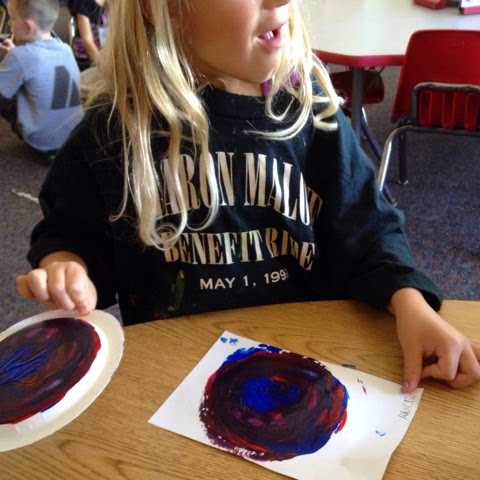We have been learning to slow down and look closer. As we wonder, inquire, and investigate, we need to slow down enough to notice things and focus on the detail. We practiced by using our own faces!
We started out by talking about feelings. We read several books about feelings and discussed that feelings are real and okay! I am always surprised when I ask kids if it is okay to be angry. Almost all of them will say no, it is not okay! Of course it is okay to get angry! If a friend is unkind to you or takes something away from you, you are allowed to get angry at them! It is how we let them know we are angry that matters. They learned about using their words, problem solving, walking away and finding an adult for help if they can't solve the problem that is making them angry. We discussed how it is never okay to hit, push, shove, kick, etc. when they are angry.
As we talked about different feelings, they looked in a mirror and looked closely at what their faces looked like when they had those feelings. We decided to document through observational drawings what their faces looked like! I got this idea from artforsmallhands.com.
They documented what their faces looked like when they were happy, sad, angry, and scared. They slowed down and really looked at what their mouthes looked like, what their eyes looked like, and what their eyebrows did!
Next we read these books and discussed how we were all alike in some ways, yet different! We all have eyes, but our eyes are all different! We all have noses, but each nose is different!
We slowed down and really looked at our faces to notice the detail and created black line observational drawings to show that detail.
The kids choose the colors of watercolor to match their skin, hair and eyes.
I do these every year because the results of them slowing down, noticing detail, and documenting the detail they noticed really showed what these kids are capable of! We added what they wanted to learn in Kindergarten and displayed these fabulous self portraits in our hallway!
We will continue to learn how to slow down and document details that we notice as we make our thinking visible during play, explorations and inquiries! Some have started as they create plans or document during their play already! The slowing down is the hardest part for them! They are used to bouncing from one thing to another, but they are getting better with practice!
Below is an observational drawing and clay sculpture of our praying mantis.
Here are some plans in the block area that showed great detail! They also did a great job of sticking to their plans!
Below is a drawing of a friends favorite part of a book she read and some friends drawings of objects on our "look closer" table.
This friend really slowed down to add details such as texture to this clay sculpture of a gourd. She added the lines that she took the time to notice!
It is amazing what they can accomplish once they learn to slow down and notice things! The kids have been noticing the changes happening outside as Fall is creatin changes around us! We will be slowing down to notice these changes in more detail! Stay tuned next week to see what they notice and learn!









































































